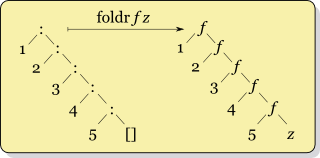One of the first higher-order functions most students encounter in a functional programming course is the fold (foldr, foldl). A fold takes an operator, an initial value and a list, and then recursively combines each element in the list using the initial value and the given operator. The recursive combining structure of a fold
The recursive combining structure of a foldThe Easy Stuff
A catamorphism is a generalization of the fold on lists. The word catamorphism has its roots in the Greek word ‘κατά’ meaning ‘downwards’. In this case it is the concept of applying a fold on any algebraic data type. An algebraic data type is any data type composed of other types – as an example, take the following data type for a binary tree I will use throughout this post.data Tree a = Empty
| Leaf a
| Node (Tree a) (Tree a)
depth :: Tree a -> Int
depth Empty = 0
depth (Leaf a) = 1
depth (Node l r) = 1 + max (depth l) (depth r)
count :: Tree a -> Int
count Empty = 0
count (Leaf a) = 1
count (Node l r) = (+) (count l) (count r)
foldTreeToInt :: (Int, a -> Int, Int -> Int -> Int) -> Tree a -> Int
foldTreeToInt (empty, leaf, node) = fTreeToInt
where
fTreeToInt Empty = empty
fTreeToInt (Leaf a) = leaf a
fTreeToInt (Node l r) = node (fTreeToInt l) (fTreeToInt r)
-- We can now easily define depth and count by specifying
-- the group of functions
depth' :: Tree a -> Int
depth' = foldTreeToInt (0, const 1, \l r -> 1 + max l r)
count' :: Tree a -> Int
count' = foldTreeToInt (0, const 1, (+))
Jeuring, J., Swierstra, D. (2011) Languages And Compilers. Utrecht University
. We can generalise the fold we created to generic data types.type TreeAlgebra a t = (t, a -> t, t -> t -> t)
foldTree :: TreeAlgebra a t -> Tree a -> t
foldTree (empty, leaf, node) = fTree
where
fTree Empty = empty
fTree (Leaf a) = leaf a
fTree (Node l r) = node (fTree l) (fTree r)
Black magic
Catamorphism is a term from category theory, of which my knowledge is anything but formal (or correct). Best to hear it from someone who knows what they are talking about.A F-algebra contains an endofunctor f, an object a and a morphism f a -> a. A functor is a mapping between categories, where an endofunctor maps a category into itself. This can be written in haskell as type Algebra f a = f a -> a.We can use fixed points as our initial algebra. A fixed point here is when you can apply some functor f to itself and get the same type, possible in haskell as newtype Fix f = Fix { unFix :: f (Fix f) }. The code for writing generic catamorphisms can now be written as.type Algebra f a = f a -> a
newtype Fix f = Fix { unFix :: f (Fix f) }
cata :: Functor f => Algebra f a -> Fix f -> a
cata f = f . fmap (cata f) . unFix
Tree and the initial algebra. We also have to remove the explicit recursion from our Tree definition.data Tree' a b = Empty'
| Leaf' a
| Node' b b
instance Functor (Tree' a) where
fmap f Empty' = Empty'
fmap f (Leaf' a) = Leaf' a
fmap f (Node' l r) = Node' (f l) (f r)
type FTree' a = Fix (Tree' a)
count'' :: FTree' a -> Int
count'' = cata phi
where
phi Empty' = 0
phi (Leaf' a) = 1
phi (Node' l r) = l + r
depth'' :: FTree' a -> Int
depth'' = cata phi
where
phi Empty' = 0
phi (Leaf' a) = 1
phi (Node' l r) = 1 + max l r
count'' and depth'' on the following example tree would evaluate to 3 and 4 respectively.-- /\
-- 3 /\
-- 1 \
-- 2
example :: FTree' Int
example = node (leaf 3) (node (leaf 1) (node empty (leaf 2)))
where
empty = Fix Empty'
leaf x = Fix (Leaf' x)
node l r = Fix (Node' l r)